2006 SUBARU TRIBECA recommended oil
[x] Cancel search: recommended oilPage 298 of 377

11
Maintenance and service
Maintenance schedule ....................................... 11-3
Maintenance precautions .................................. 11-3 Before checking or servicing in the engine compartment ........................................................ 11-4
When you do checking or servicing in the
engine compartment while the engine is
running .................................................................. 11-4
Engine hood ....................................................... 11-4
Engine compartment overview ......................... 11-6
Engine oil ............................................................ 11-7 Checking the oil level ............................................. 11-7
Changing the oil and oil filter ................................ 11-7
Recommended grade and viscosity ..................... 11-9
Recommended grade and viscosity under severe driving conditions .................................... 11-10
Cooling system .................................................. 11-10 Hose and connections ........................................... 11-11
Engine coolant ........................................................ 11-11
Air cleaner element ............................................ 11-13 Replacing the air cleaner element ......................... 11-13
Spark plugs ......................................................... 11-14 Recommended spark plugs ................................... 11-14
Drive belts ........................................................... 11-15
Automatic transmission fluid ............................ 11-15 Checking the fluid level ......................................... 11-15
Recommended fluid ............................................... 11-16
Front differential gear oil ................................... 11-16 Checking the oil level ............................................. 11-16 Recommended grade and viscosity ..................... 11-17
Rear differential gear oil .................................... 11-17 Checking the gear oil level .................................... 11-17
Recommended grade and viscosity ..................... 11-18
Power steering fluid ........................................... 11-19 Checking the fluid level .......................................... 11-19
Recommended fluid ............................................... 11-19
Brake fluid ........................................................... 11-20 Checking the fluid level .......................................... 11-20
Recommended brake fluid ..................................... 11-20
Brake booster ..................................................... 11-21
Brake pedal ......................................................... 11-21 Checking the brake pedal free play ...................... 11-21
Checking the brake pedal reserve distance ......... 11-21
Replacement of brake pad and lining ............... 11-22 Breaking-in of new brake pads and linings .......... 11-22
Parking brake stroke .......................................... 11-23
Tires and wheels ................................................ 11-23 Types of tires .......................................................... 11-23
Tire pressure monitoring system (TPMS) ............ 11-23
Tire inspection ........................................................ 11-25
Tire pressures and wear ........................................ 11-25
Wheel balance ......................................................... 11-27
Wear indicators ....................................................... 11-27
Tire rotation ............................................................. 11-28
Tire replacement ..................................................... 11-28
Wheel replacement ................................................. 11-29
Aluminum wheels ............................................... 11-29
Page 306 of 377
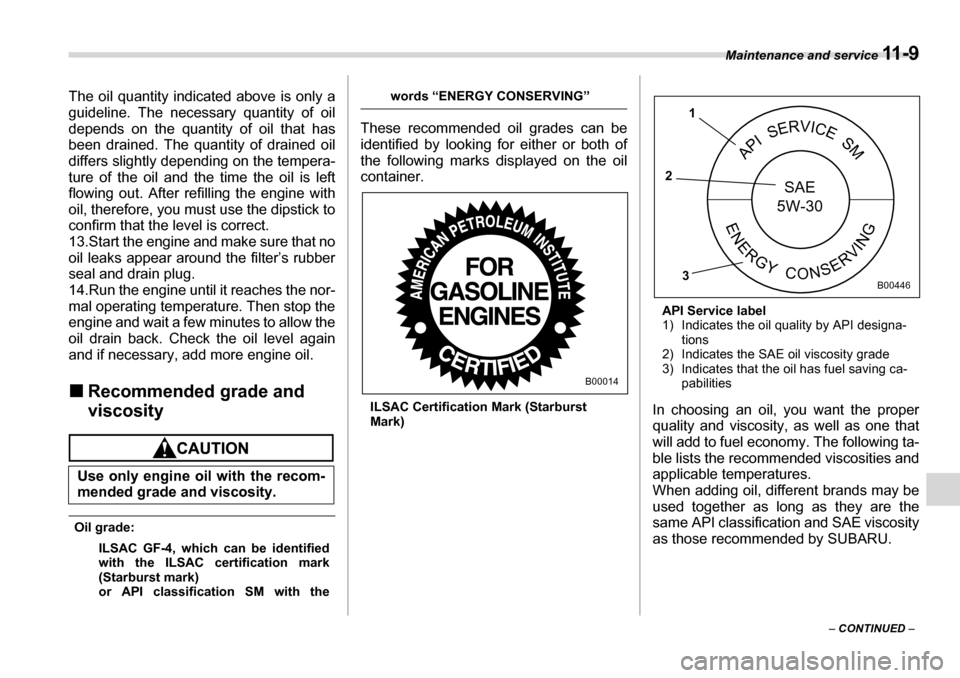
Maintenance and service 11 - 9
– CONTINUED –
The oil quantity indicated above is only a
guideline. The necessary quantity of oil
depends on the quantity of oil that has
been drained. The quantity of drained oil
differs slightly depending on the tempera-
ture of the oil and the time the oil is left
flowing out. After refilling the engine with
oil, therefore, you must use the dipstick to
confirm that the level is correct.
13.Start the engine and make sure that no
oil leaks appear around the filter’s rubber
seal and drain plug.
14.Run the engine until it reaches the nor-
mal operating temperature. Then stop the
engine and wait a few minutes to allow the
oil drain back. Check the oil level again
and if necessary, add more engine oil. �„
Recommended grade and
viscosity
Oil grade:
ILSAC GF-4, which can be identified
with the ILSAC certification mark(Starburst mark)
or API classification SM with the
words “ENERGY CONSERVING”
These recommended oil grades can be
identified by looking for either or both of
the following marks displayed on the oil
container.
ILSAC Certification Mark (Starburst Mark) API Service label
1) Indicates the oil quality by API designa-
tions
2) Indicates the SAE oil viscosity grade
3) Indicates that the oil has fuel saving ca- pabilities
In choosing an oil, you want the proper
quality and viscosity, as well as one that
will add to fuel economy. The following ta-
ble lists the recommended viscosities and
applicable temperatures.
When adding oil, different brands may be
used together as long as they are the
same API classification and SAE viscosity
as those recommended by SUBARU.
Use only engine oil with the recom-
mended grade and viscosity.
B00014
APISERVICESM
ENERGYCONSERVING
SAE
5W-30
1
2
3
B00446
Page 307 of 377
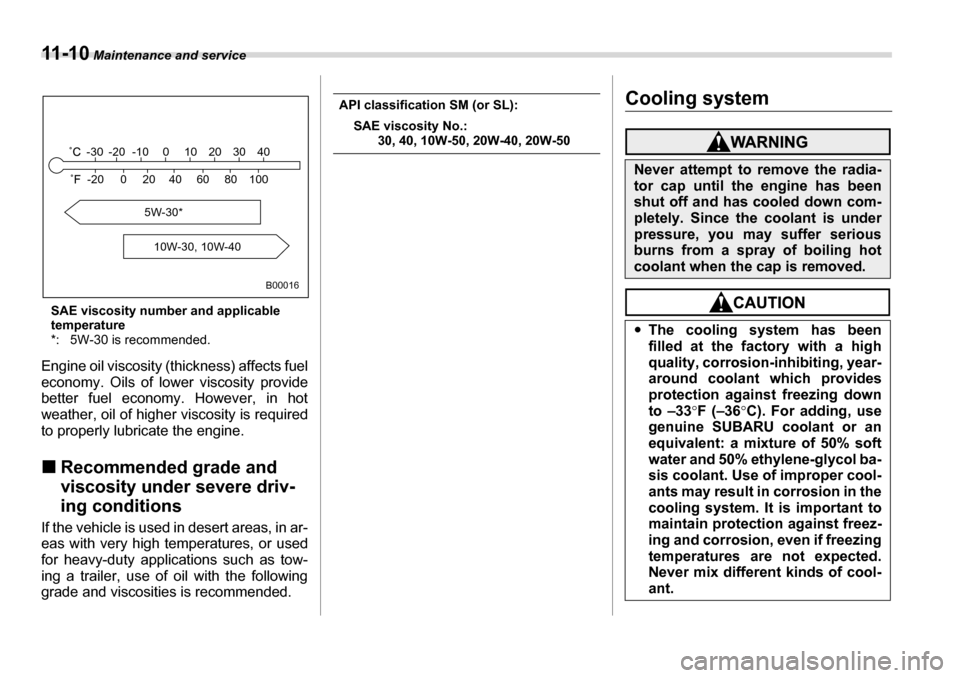
11 - 1 0 Maintenance and service
SAE viscosity number and applicable
temperature
*: 5W-30 is recommended.
Engine oil viscosity (thickness) affects fuel
economy. Oils of lower viscosity provide
better fuel economy. However, in hot
weather, oil of higher viscosity is required
to properly lubricate the engine. �„ Recommended grade and
viscosity under severe driv-
ing conditions
If the vehicle is used in desert areas, in ar-
eas with very high temperatures, or used
for heavy-duty applications such as tow-
ing a trailer, use of oil with the following
grade and viscosities is recommended.
API classification SM (or SL):
SAE viscosity No.:
30, 40, 10W-50, 20W-40, 20W-50
Cooling system
5W-30*
10W-30, 10W-40
-30 -20 -10 0 10 20 30 40
-20 0 60 20 80 10040
B00016
Never attempt to remove the radia-
tor cap until the engine has been
shut off and has cooled down com-
pletely. Since the coolant is under
pressure, you may suffer serious
burns from a spray of boiling hot
coolant when the cap is removed. �yThe cooling system has been filled at the factory with a high
quality, corrosion-inhibiting, year-
around coolant which provides
protection against freezing down
to –33 °F (–36 °C). For adding, use
genuine SUBARU coolant or an
equivalent: a mixture of 50% soft
water and 50% ethylene-glycol ba-
sis coolant. Use of improper cool-
ants may result in corrosion in the
cooling system. It is important tomaintain protection against freez-
ing and corrosion, even if freezing
temperatures are not expected.
Never mix different kinds of cool-
ant.
Page 313 of 377
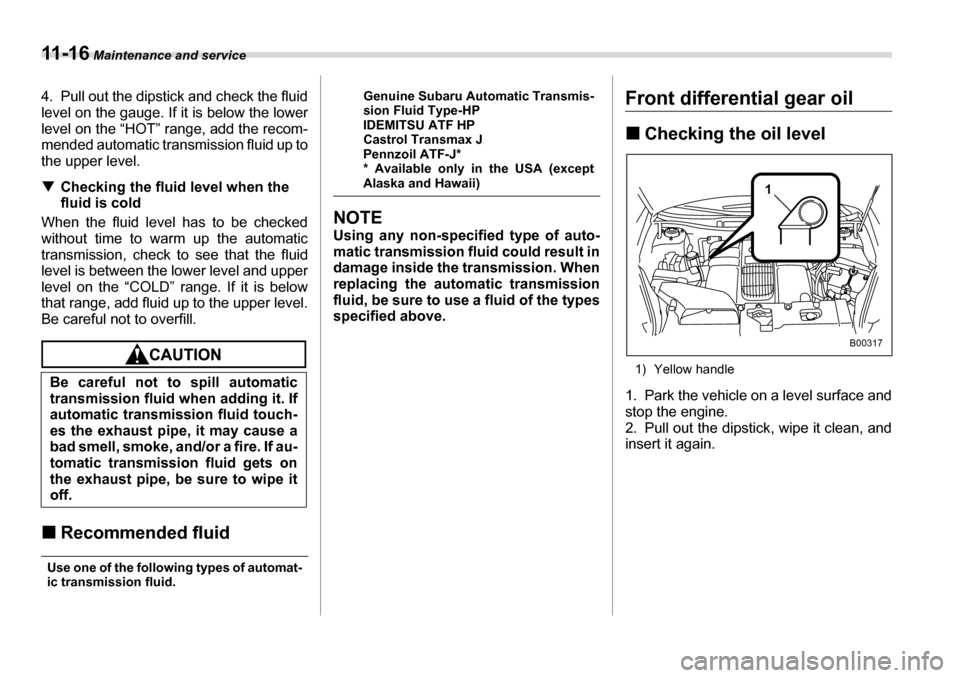
11 - 1 6 Maintenance and service
4. Pull out the dipstick and check the fluid
level on the gauge. If it is below the lower
level on the “HOT” range, add the recom-
mended automatic transmission fluid up to
the upper level. �TChecking the fluid level when the
fluid is cold
When the fluid level has to be checked
without time to warm up the automatic
transmission, check to see that the fluid
level is between the lower level and upper
level on the “COLD” range. If it is below
that range, add fluid up to the upper level.
Be careful not to overfill.
�„ Recommended fluid
Use one of the following types of automat-
ic transmission fluid. Genuine Subaru Automatic Transmis-
sion Fluid Type-HP
IDEMITSU ATF HP
Castrol Transmax J
Pennzoil ATF-J*
* Available only in the USA (except
Alaska and Hawaii)
NOTE
Using any non-specified type of auto-
matic transmission fluid could result in
damage inside the transmission. When
replacing the automatic transmission
fluid, be sure to use a fluid of the types
specified above.
Front differential gear oil �„
Checking the oil level
1) Yellow handle
1. Park the vehicle on a level surface and
stop the engine.
2. Pull out the dipstick, wipe it clean, and
insert it again.
Be careful not to spill automatic
transmission fluid when adding it. If
automatic transmission fluid touch-
es the exhaust pipe, it may cause a
bad smell, smoke, and/or a fire. If au-
tomatic transmission fluid gets on
the exhaust pipe, be sure to wipe itoff.
1
B00317
Page 314 of 377
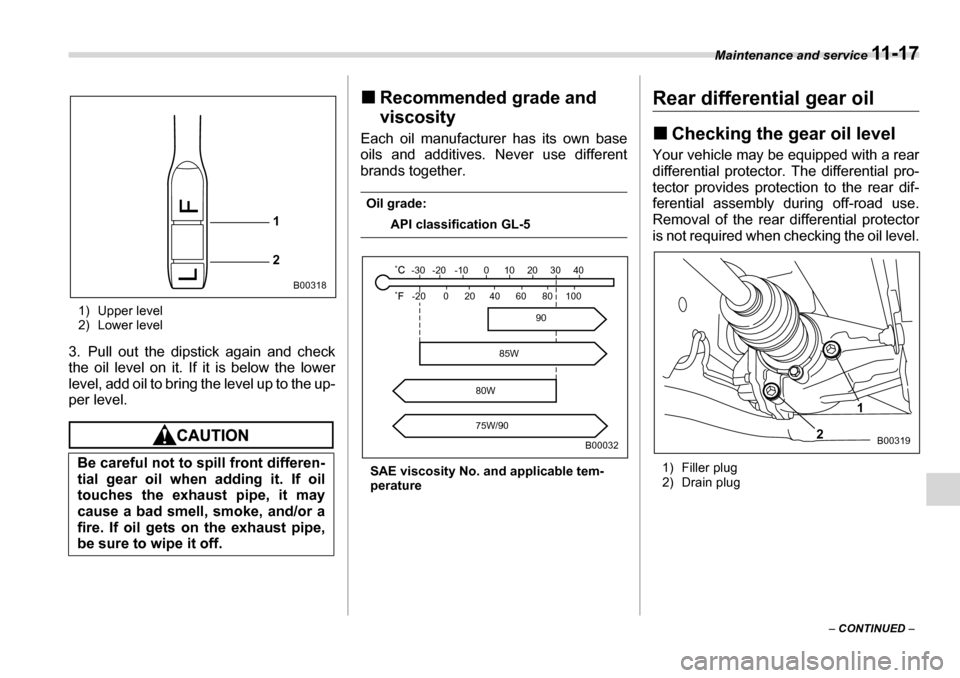
Maintenance and service 11 - 1 7
– CONTINUED –
1) Upper level
2) Lower level
3. Pull out the dipstick again and check
the oil level on it. If it is below the lower
level, add oil to bring the level up to the up-
per level.
�„ Recommended grade and
viscosity
Each oil manufacturer has its own base
oils and additives. Never use different
brands together.
Oil grade:
API classification GL-5
SAE viscosity No. and applicable tem-
perature
Rear differential gear oil �„ Checking the gear oil level
Your vehicle may be equipped with a rear
differential protector. The differential pro-
tector provides protection to the rear dif-
ferential assembly during off-road use.
Removal of the rear differential protector
is not required when checking the oil level.
1) Filler plug
2) Drain plug
Be careful not to spill front differen-
tial gear oil when adding it. If oil
touches the exhaust pipe, it may
cause a bad smell, smoke, and/or a
fire. If oil gets on the exhaust pipe,
be sure to wipe it off.
L
F
1 2
B00318-30 -20 -10 0 10 20 30 40
-20 0 60 20
80W 75W/90 80 100
40
85W 90
B00032
1
2
B00319
Page 315 of 377
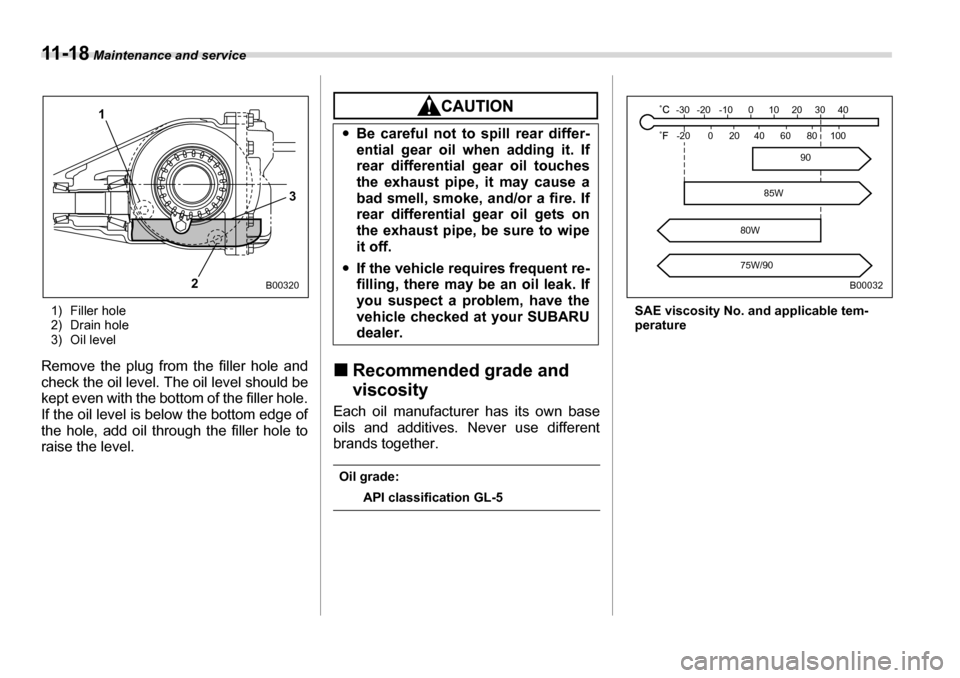
11 - 1 8 Maintenance and service
1) Filler hole
2) Drain hole
3) Oil level
Remove the plug from the filler hole and
check the oil level. The oil level should be
kept even with the bottom of the filler hole.
If the oil level is below the bottom edge of
the hole, add oil through the filler hole to
raise the level.
�„ Recommended grade and
viscosity
Each oil manufacturer has its own base
oils and additives. Never use different
brands together.
Oil grade:
API classification GL-5 SAE viscosity No. and applicable tem- perature
1
2 3
B00320
�y
Be careful not to spill rear differ-
ential gear oil when adding it. If
rear differential gear oil touches
the exhaust pipe, it may cause a
bad smell, smoke, and/or a fire. If
rear differential gear oil gets on
the exhaust pipe, be sure to wipe
it off.
�y If the vehicle requires frequent re-
filling, there may be an oil leak. If
you suspect a problem, have the
vehicle checked at your SUBARU
dealer.
-30 -20 -10 0 10 20 30 40
-20 0 60 20
80W 75W/90 80 100
40
85W 90
B00032
Page 316 of 377
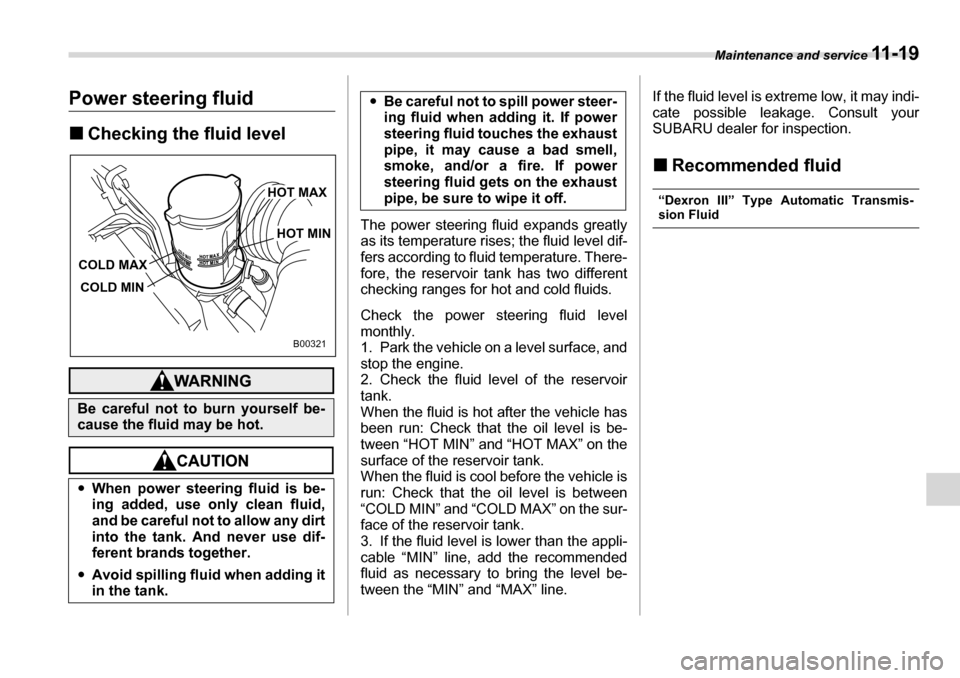
Maintenance and service 11 - 1 9
Power steering fluid �„Checking the fluid level
The power steering fluid expands greatly
as its temperature rises; the fluid level dif-
fers according to fluid temperature. There-
fore, the reservoir tank has two different
checking ranges for hot and cold fluids.
Check the power steering fluid level
monthly.
1. Park the vehicle on a level surface, and
stop the engine.
2. Check the fluid level of the reservoir
tank.
When the fluid is hot after the vehicle has
been run: Check that the oil level is be-
tween “HOT MIN” and “HOT MAX” on the
surface of the reservoir tank.
When the fluid is cool before the vehicle is
run: Check that the oil level is between
“COLD MIN” and “COLD MAX” on the sur-
face of the reservoir tank.
3. If the fluid level is lower than the appli-
cable “MIN” line, add the recommended
fluid as necessary to bring the level be-
tween the “MIN” and “MAX” line. If the fluid level is extreme low, it may indi-
cate possible leakage. Consult your
SUBARU dealer for inspection. �„
Recommended fluid
“Dexron III” Type Automatic Transmis-sion Fluid
Be careful not to burn yourself be-
cause the fluid may be hot. �yWhen power steering fluid is be-
ing added, use only clean fluid,
and be careful not to allow any dirt
into the tank. And never use dif-ferent brands together.
�y Avoid spilling fluid when adding it
in the tank.
HOT MAX
COLD MAX HOT MIN
COLD MIN
B00321
�y Be careful not to spill power steer-
ing fluid when adding it. If power
steering fluid touches the exhaust
pipe, it may cause a bad smell,
smoke, and/or a fire. If power
steering fluid gets on the exhaust
pipe, be sure to wipe it off.
Page 373 of 377

14-6 Index
Power Door locking switches .................................................... 2-6
Seat ............................................................................... 1-3
Steering fluid ............................................................. 11-19
Windows ...................................................................... 2-19
Precautions against vehicle modification ................ 1-29, 1-68
Preparing to drive ............................................................... 7-6
Printed antenna .................................................................. 5-2 R
Rear Air conditioner ................................................................ 4-9
Combination lights ..................................................... 11-42
Differential gear oil ..................................................... 11-17
Gate ............................................................................. 2-22
Seats ............................................................................. 1-6
Rear seat/Second seat ....................................................... 1-6
Rear window Defogger button ........................................................... 3-33
Wiper and washer switch ............................................. 3-32
Recommended
Automatic transmission fluid ...................................... 11-16
Brake fluid ................................................................. 11-20
OIL grade and viscosity .............. 11-9, 11-10, 11-17, 11-18
Power steering fluid ................................................... 11-19
Spark plugs ............................................................... 11-14
Remote keyless entry system ............................................ 2-8
Replacement Brake pad and lining .................................................. 11-22
Wiper blades .............................................................. 11-31
Replacing Air cleaner element .................................................... 11-13 Battery (Remote keyless entry system) ....................... 2-10
Lost transmitters (keyless entry system) ...................... 2-11
Replacing bulbs .............................................................. 11-39 Cargo area light ......................................................... 11-46
Dome light .................................................................. 11-44
Door step light ............................................................ 11-45
Front fog light ............................................................. 11-42
Front turn signal light ................................................. 11-42
Headlight .................................................................... 11-40
License plate light ...................................................... 11-44
Map light .................................................................... 11-45
Parking light ............................................................... 11-41
Rear combination light ............................................... 11-42
Rocking the vehicle .......................................................... 8-11
Roof rail and crossbar ...................................................... 8-13 S
Safety
Precautions when driving .................................................. 4
Symbol .............................................................................. 2
Warnings ........................................................................... 2
Seat Fabric ........................................................................... 10-4
Heater ............................................................................ 1-6
Seatbelt ................................................................................. 4 Maintenance ................................................................ 1-26
Pretensioners ............................................................... 1-27
Safety tips .................................................................... 1-15
Warning light and chime .............................................. 1-17
Seatbelts ........................................................................... 1-15
Second-row seats ............................................................... 1-6
Selector lever ............................................................. 7-9, 7-10